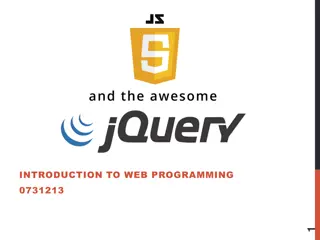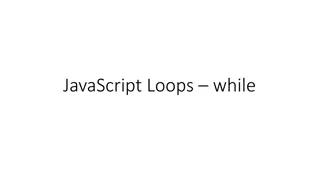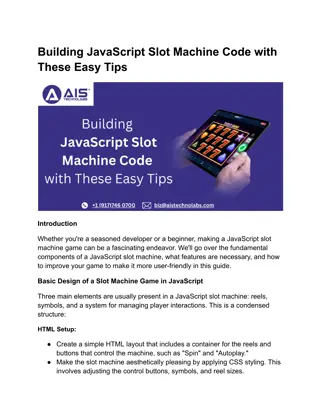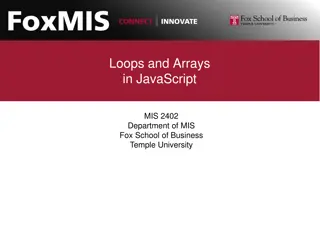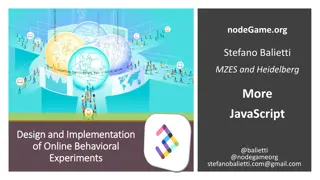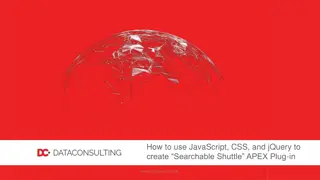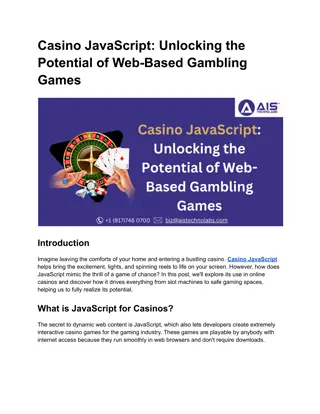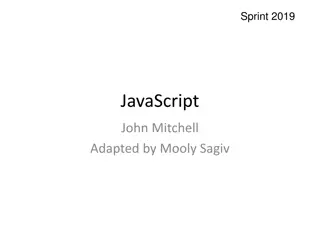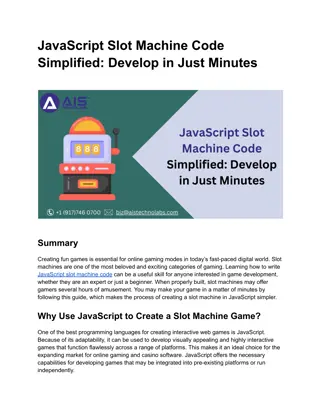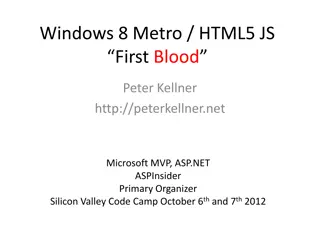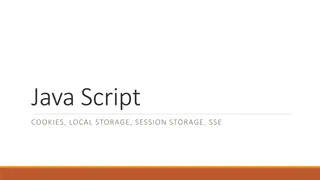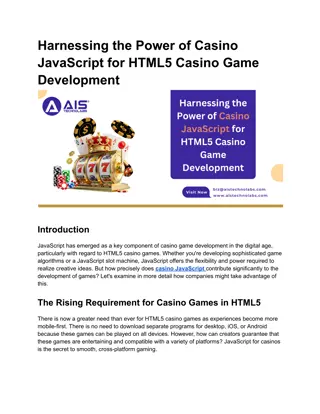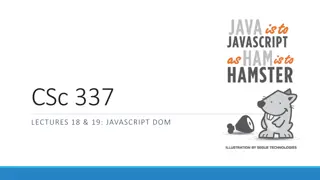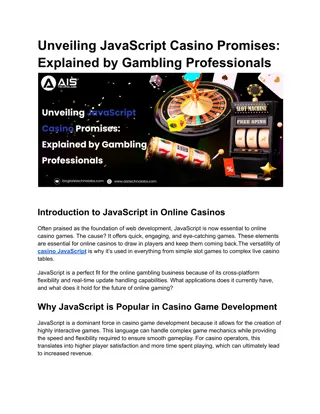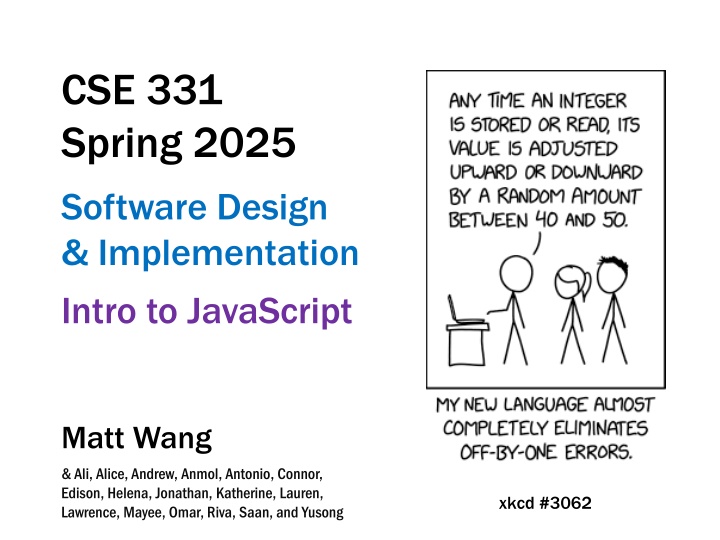
Exploring Computer Science Through CSE 331 Spring 2025 with Matt Wang and TAs
Dive into the world of computer science with CSE 331 Spring 2025 led by Matt Wang and a team of 17 TAs. Discover the foundations of software design, implementation, JavaScript, and more. Gain insights from experienced professionals and embrace the learning journey in this innovative course.
Download Presentation

Please find below an Image/Link to download the presentation.
The content on the website is provided AS IS for your information and personal use only. It may not be sold, licensed, or shared on other websites without obtaining consent from the author. If you encounter any issues during the download, it is possible that the publisher has removed the file from their server.
You are allowed to download the files provided on this website for personal or commercial use, subject to the condition that they are used lawfully. All files are the property of their respective owners.
The content on the website is provided AS IS for your information and personal use only. It may not be sold, licensed, or shared on other websites without obtaining consent from the author.
E N D
Presentation Transcript
CSE 331 Spring 2025 Software Design & Implementation Intro to JavaScript Matt Wang & Ali, Alice, Andrew, Anmol, Antonio, Connor, Edison, Helena, Jonathan, Katherine, Lauren, Lawrence, Mayee, Omar, Riva, Saan, and Yusong xkcd #3062
Hello, World! I m Matt (he/him), teaching professor in Allen School have been in intro-adjacent for a bit, teaching 331 for the first time small research background in programming languages, large professional background in web dev one spin: have written code used by thousands -- millions of devs, daily* but: have written bugs that have affected millions of devs* goal: don t make my mistakes! 2
Hello, TAs! 17 lovely TAs this quarter ~ 1:15 ratio which is amazing better perspective than me on student experience in the class, tips & tricks, lets us have ~ 19 hours of office hours / week quiz sections are co-taught meet your TAs on Thursday! 3
Shoulders of Giants Materials designed over many iterations of 331 These folks (& others) deserve the flowers 50+ years of professional programming experience 30+ years of research in creating correct software course is their (+ our) collective wisdom all mistakes are Matt s :) 4
You & Computer Science (approximately) You already know Java some basic data structures and algorithms Working on expanding your knowledge Data Programming Languages Structures Java Algorithms Databases 5
Learning More Computer Science Operating Systems Compilers Distributed Systems Data Programming Languages Structures Machine Learning Networking Java Algorithms AI Databases Graphics 6
Traits of Learning Computer Science 1. First time solving this kind of problem 2. Given lots of help will often tell you if it s right 3. Expected to make mistakes 90% is an A ! All of these are different in industry Skills 7
Traits of Practicing Computer Science 1. Not the first time solving this kind of problem normal to hire someone with prior experience learn new skills in class or in spare time 2. No one to tell you if your code is right That s your job! (senior engineers will double check your work, but they expect it to be right) you will almost never be given tests Skills 8
Least Real World Setting Possible Would give you a button to click to see if it s right Someone else already solved this problem. They only need you for new problems. 9
Practicing Computer Science: Mistakes 1. Not the first time solving this kind of problem normal to hire someone with prior experience learn new skills in class or in spare time 2. No one to tell you if your code is right That s your job! (senior engineers will double check your work, but they expect it to be right) you will almost never be given tests 3. Mistakes are not acceptable (to users) 90% is not an A 10% of 1m users is 100k users calling customer service 1% of 1m users is 10k users calling customer service Skills 10
What This Class is About Learning what engineers do to make sure their code is correct before sending it to users Learn a toolkit for being 100% sure it is right any computer scientist must know this Learn when to use the toolkit not every problem requires it 11
We Will Ask You to Write Code Differently Differently Our goal is not looks exactly like what you will see in industry nor is it to use the libraries most common in industry the most popular languages and libraries change all the time not to teach you to write code that Our goal is to teach you to think to understand understand how all the parts work think through your code and That is best served by writing slowly and carefully We will force that by 1. changing programming languages to something unfamiliar 2. having unusual coding conventions at times 12
Homework CSE 331 is a hard because coding & debugging are hard! hard class Most of the work is done outside of class university policy is 2 hours per hour of class time plan for 8 hours per week, but outside of class Wide variation in time required some students will average 10-15 hours but this is not expected! be sure to get help if you are averaging over 15 hours (~ debug your approach to 331) 13
Homework Assignments Nine assignments split into these groups: HW1 HW2 HW3 learn to write more complex apps practice debugging HW4 HW5 HW6 learn how to be 100% sure the code is correct (most of the work done on paper) HW7 HW8 HW9 learn to use the tools productively (when to use then and when not to) 14
The Cadence of the Course ~ 1 topic per week, usually ending on Wed Thu quiz section: practice & ramp-in to HW HW released Thu night, due following Wed assumes you ve gone to section! section worksheet is HW warmup by release, know all content needed to do HW capstone of topic (and great exam studying) 15
Syllabus Pause (and, answering your questions)
Learning a New Language We re going to learn some JavaScript The second language can be the hardest to learn! some things you took for granted no longer hold must slow down think about think about every step We will move slowly we won t use all the language this quarter will not learn every feature of the language comparison with Java will be useful 17
Running JavaScript Can be run in different environments command line (like Java) instead of "java MyClass", it is "node mycode.js" inside the browser Primarily interesting because of the browser likely would not be used much otherwise command line provided so you can use one language for both In both environments, print output with console.log(..) prints to command line or Developer Console in the browser 18
History of JavaScript Incredibly simple language created in 10 days by Brendan Eich in 1995 often difficult to use because it is so simple Features added later to fix problem areas imports (ES6) classes (ES6) integers (ES2020) 21
Relationship to Java Initially had no relation to Java picked the name because Java was popular then added Java s Math library to JS also e.g., Math.sqrt is available in JS, just like Java copied someof Java s String functions to JS string Both are in the C family of languages much of the syntax is the same more differences in data types We will discuss syntax (code) first and then data 22
JavaScript Syntax Both are in the C family of languages Much of the syntax is the same most expressions (+, -, *, /, ?:, function calls, etc.) if, for , while , break , continue , return comments with // or /* .. */ Different syntax for a few things declaring variables declaring functions equality (===) 23
Java vs JavaScript Syntax The following code is legal in both languages: assume s and j are already declared s = 0; j = 0; while (j < 10) { s += j; j++; } ORfor (j = 0; j < 10; j++) // Now s == 45 24
Differences from Java: Type Declarations JavaScript variables have no declared types this is a problem (we will get them back later) Declare variables in one of these ways: const x = 1; let y = "foo"; const cannot be changed; let can be changed use const whenever possible! 25
Basic Data Types of JavaScript JavaScript includes the following runtime types number bigint string boolean undefined null Object Array (another undefined) (special subtype of Object) 26
Differences from Java: === operator JavaScript s == is problematic tries to convert objects to the same type e.g., 3 == "3" and even 0 == ""are true?!? We will use === (and !== ) instead: no type conversion will be performed e.g., 3 === "3" is false Mostly same as Java compares values on primitives, references on objects but strings are primitive in JS (no .equals needed) == on strings common source of bugs in Java 27
Checking Types at Run Time Condition Code x === undefined x === null typeof x === "number" typeof x === "bigint" typeof x === "string" typeof x === "object" Array.isArray(x) x is undefined x is null x is a number x is an integer x is a string x is an object or array (or null) x is an array 28
Numbers bigint number integers floating point (like Java double) By default, JS uses number not bigint 0, 1, 2 are numbers not integers add an n at the end for integers (e.g., 2n) All the usual operators: + - * / ++ -- += division is different with number and bigint we will prefer bigint because correctness is more important Math library largely copied from Java e.g., Math.sqrt returns the square root 29
Strings Mostly the same as Java immutable string concatenation with + A few improvements string comparison with === and < no need for s.equals(t) just write s === t use either .. or .. (single or double quotes) new string literals that support variable substitution: const name = "Fred"; console.log(`Hi, ${name}!`); // prints Hi, Fred! 30
Boolean All the usual operators: && || ! if can be used with any value falsey things: false, 0, NaN, "", null, undefined truthy things: everything else A common source of bugs stick to boolean values for all conditions 31
Record Types JavaScript Object is something with fields JavaScript has special syntax for creating them const p = {x: 1n, y: 2n}; console.log(p.x); // prints 1n The term object is potentially confusing used for many things I prefer it as shorthand for mathematical object Will refer to things with fields as records normal name in programming languages 32
Record Types: Field Names Quotes are optional around field names const p = {x: 1n, y: 2n}; console.log(p.x); // prints 1n const q = {"x": 1n, "y": 2n}; console.log(q.x); // also prints 1n Field names are literal strings, not expressions! const x = "foo"; console.log({x: x}); // prints { x : foo } 33
Record Types: Checking Presence Retrieving a non-existent field returns undefined const p = {x: 1n, y: 2n}; console.log(p.z); // prints undefined Can also check for presence with in console.log("x" in p); // prints true console.log("z" in p); // prints false Be careful: all records have hidden properties console.log("toString" in p); // prints true! 34
Maps Do not try to use a record as a map! usually why reason people use in and p["name"] Just use Map instead: const M = new Map([["a", 1], ["b", 5]]); console.log(M.get("a")); // prints 1 console.log(M.get("a")); // prints 5 console.log(M.get("toString")); // prints undefined M.set("a", 2); M.set("c", 3); console.log(M.get("a")); // prints 2 console.log(M.get("c")); // prints 3 35
Sets JavaScript also provides Set: const S = new Set(["a", "b"]); console.log(S.has("a")); // prints true console.log(S.has("c")); // prints false S.add("c"); console.log(S.has("c")); // prints true Constructor takes an (optional) list of initial values constructor of Map takes a list of pairs 36
Arrays (like Java ArrayLists) Simpler syntax for literals: const A = [1, 2, "foo"]; // no type restriction! console.log(A[2]); // prints foo Add and remove using push and pop: A.pop(); console.log(A); // prints [1, 2] A.push(3); console.log(A); // prints [1, 2, 3] 37
Arrays as Objects Length field stores the length of the array const A = [1, 2, "foo"]; console.log(A.length); // prints 3 A.pop(); console.log(A.length); // prints 2 Arrays are a special type of object: console.log(typeof A); // prints object console.log(Array.isArray(A)); // prints true console.log(Array.isArray({x: 1})); // prints false 38
Functions Functions are first class objects arrow expressions creates functions store these into a variable to use it later const add2 = (x, y) => x + y; console.log(add2(1n, 2n)); // prints 3n const add3 = (x, y, z) => { return x + y + z; }; console.log(add3(1n, 2n, 3n)); // prints 6n 39
Declaring and Using Functions We will declare functions like this const add = (x, y) => { return x + y; }; // add(2n, 3n) == 5n Functions can be passed around functional programming language but we won t do that (much) this quarter we will pass functions to buttons to tell them what to do when clicked see CSE 341 for more on that topic 40
Classes Class syntax is similar to Java but no types: class Pair { constructor(x, y) { this.x = x; this.y = y; } } const p = new Pair(1, 2); const q = new Pair(2, 2); fields are not declared (because there are no types) constructor is called constructor not class name 41
Declaring Classes We will declare classes like this: class Pair { distTo = (p) => { const dx = this.x p.x; const dy = this.y p.y; return Math.sqrt(dx*dx + dy*dy); }; } console.log(p.distTo(q)); // prints 1 this assignment is executed as part of the constructor there is another syntax for method declarations but avoid it leads to big problems when we are writing UI shortly 42
JavaScript Summary (1/2) Most of the syntax is the same even has Map and Set like Java Main difference is no declared types That means new syntax for declaring variables, functions, and classes checking type a runtime with typeof That means you can mix types in expressions but you don't want to! avoid this! use explicit type conversions (e.g. Number(..)) if necc. 43
JavaScript Summary (2/2) A few new features that are useful Strings are primitive types can use "===" and "<" on them simpler syntax for accessing characters: "s[1]" Integers have their own type literals use an "n" suffix, e.g., "3n" "/" is then integer division New syntax for string literals: `Hi, ${name}` 44
CSE 331 Spring 2025 Software Design & Implementation JS Weekly Wednesday Why does 5 + - '2' evaluate to 3 in JS? HTTP Basics How would JS evaluate: '5' + - + + - + - - '2' Matt Wang & Ali, Alice, Andrew, Anmol, Antonio, Connor, Edison, Helena, Jonathan, Katherine, Lauren, Lawrence, Mayee, Omar, Riva, Saan, and Yusong
Imports Originally, all JavaScript lived in the same "namespace" problems if two programmers use the same function name tools would rename functions to avoid conflicts (e.g., webpack) Now, by default, declarations are hidden outside the file Add the keyword export to make it visible export const MAX_NUMBER = 15; // in src/foo.js Use the import statement to bring into another file import { MAX_NUMBER } from './foo.js'; // in src/bar.js ./foo.js is relative path from this file to foo.js 47
Imports in (and out) of this class export const MAX_NUMBER = 15; // in src/foo.js import { MAX_NUMBER } from ./foo.js ; // in src/bar.js For code you write, you will only need this syntax JS includes other ways of importing things full explanation is very complicated don t worry about it Starter code will include some that look different, e.g.: import express from 'express'; import './foo.png'; // include a file along with the code 48
Put Code in Multiple Files Each file is a separate namespace ("module") names can be shared (exported) or kept private Use npm (package manager) to enable this behavior file called package.json contains project setup scripts run node with module system enabled { "name": "my-project", "type": "module", "scripts": { "exec": "node src/index.js" } } 49
Packages import express from 'express'; This imports from a package called "express" use package name not a relative path (like "./foo.js") Use npm to download libraries in package.json: "dependencies": { "express": "^4.2.1" } second part is the version number we want to use getting the wrong version can make things break, so be specific "npm install" downloads all libraries listed here 50

